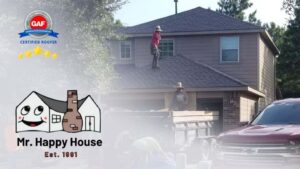
Best GAF Certified Roofers in The Woodlands, TX – Quality Roof Replacement, Gutters & Siding
Best GAF Certified Roofers in The Woodlands, TX – Quality Roof Replacement, Gutters & Siding Best GAF Certified Roofers in The Woodlands, TX – Quality
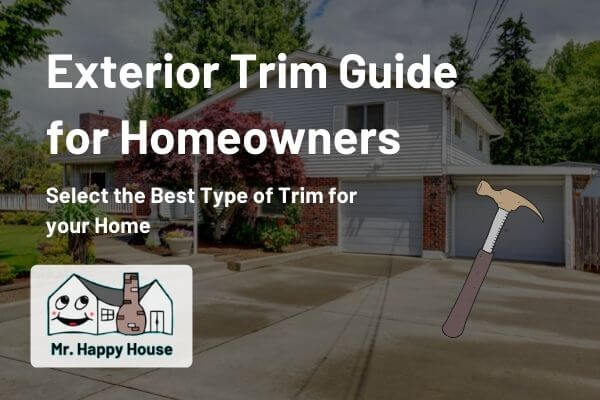
There are many components that make a house look great. One of the final touches that is absolutely necessary for every home is the exterior trim. Which is why we made an exterior trim guide for homeowners. We will dive into the different types of exterior house trim there are.
There are many ways to make your home stand out such as pressure washing, painting, installing a new roof, etc., but one of the most important, yet the most unnoticed part of the home, is the exterior trim!
What is exterior house trim? What does it look like?
Well, keep scrolling, because this guide is going to be interesting. Not only will we explain the different types of exterior trim, but sometimes homeowners mistake siding or parts of the roof as trim. You may even be wondering what the purpose of exterior house trim is besides decoration.
A home’s exterior has two general roles:
1. Protection from elements of nature. The siding and roof protect you from the scorching sun and driving rain.
2. It gives a visual or aesthetic appeal The exterior trim details merge your home’s function and form together.
The siding and roof work function systematically. To indicate where your horizontal and vertical siding lines start and where your inclined roof section ends, there are visible lines. However, there are numerous gray areas where finishing and frame trim members for holding together the exterior lines.
To endure load pressure due to gravity, they require strength. Besides, they must be long lasting and durable to withstand weather. Furthermore, they must be finished properly to stress the theme. Exterior trim details like frieze, fascia, and rake do the required task. Others are greatly exposed to weather and strain compared to others, but every one of them is a crucial part of the system.
Some of these trim components have overlapping purposes and dual meanings. Below are the most usual exterior trim pieces:
• Rake boards
• Soffits
• Fascia boards
• Boxends and gutters
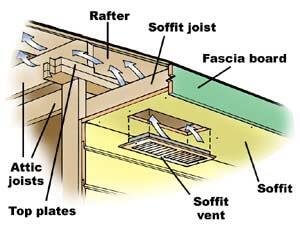
These are the horizontal boards that tie your truss tails and rafters together. It may seem insignificant but it serves a vital structural role. Overhangs and roof eaves are bound by fascia boards to offer lateral rigidity.
They prevent the lower line of your roof from sagging and separating by keeping it together. Besides, they provide strength to mount gutters. Oftentimes, there is a huge amount of weight that is transferred from the roof shingles down to the gutters, especially during rainstorms.
During heavy rains a lot of water loads to your gutters, and since a gallon of water has ten pounds, a lot of weight is exerted to your gutters. These gutters depend only on the fascia boards to remain put.
Fascia boards receive massive strains when debris and leaves clog the gutters and obstruct the flow of the water.
We have two main fascia board types:
• Exposed fascia
This trim peeks below the gutters, this exposure offers less structural integrity than decoration. It is mostly wood that is grade-finished and has been painted a different color. When this is done perfectly, an exposed fascia board dramatically affects the view.
• Hidden fascia
They cannot be seen because the fascia line is above the gutters and directly connect against the soffits. Hidden fascia boards don’t require maintenance as they are not exposed. They tie the truss tails together and are composed of rough-grade framing lumber. The fascia board is a funny-sounding name.
The word fascia means “face” in Latin. We have no completely correct fascia pronunciation. It all depends on where you come from and your schooling. Most people pronounce it “fay-she” while others pronounce it “fa-cee-ah” or “fa-she-ya.”
In terms of exterior trim, the term rake means an inclined trim piece that angles up along exposed peaks or roof gables. Rakes serve as the frieze board extensions and they may be flat along the wall.
They make a corner between the soffit and siding. You may also produce rakes that are two feet from your wall to finish the end of a gable overhang. Rake boards are parallel to or follow the roof pitch. This can be measured in the form of a rise and run equation. Rakes are mostly miter-joined at the roof’s ridge.
Since there is no correct way of finishing the lower edges of the rake, they can be finished flush or plumb or cut at 90 degrees to your horizontal plane. It is a detail used for decoration and adds to the curb appeal of your home.
To top your home architectural statement, rake boards are very critical. Most of them are made off knot-free, tight-grained lumber which may be stained or painted. Rakes are made to endure weather exposure.
The word Soffits refers to fixing underneath in French, and this is exactly what the soffits are meant for. They protect the lower roof from wind and rain since they are fitted under the eaves.
They prevent hornets, wasps, and bees from nesting and guard the attic against invaders like squirrels, bats, and birds.
Soffits are essential as they help prevent the entry of rain that is wind-driven in the house and controlling moisture. To flow air to the vents on the roof ridge from the lower roof edge, you need vented soffits. Humidity that accumulates in the attic causes mold, and this flesh flow of air helps prevent its formation.
Over the years, many materials have been used to make soffits. In the majority of older homes, light-weight, grooved, and tongue soffits were used. To enhance reflection, they were light shades, and their color suited the house’s color scheme. They drilled holes on wood soffits for ventilation.
The holes are small to control the entry of pests into the house. One of the best soffit materials that are known for great aesthetics and durability is James Hardie Soffit.
A significant challenge for siding contractors and builders is the boxend trim. In trim and roof detailing, boxends are the no man’s land. It is where the siding and soffits come together with the corners of frieze and rake boards.
Besides, it is where the gutters begin and end. It may be difficult to finish the boxends depending on the surface material and the rake angle. Oftentimes, boxends require compound miter cuts that are challenging to do, particularly when working with various materials. Instead of fighting with boxends, most builders build out boxends and highlight them using paint and trim to make these transitions into statements.
In rainy climates, gutters are very crucial. They are attached to the fascia boards horizontally and get their support from the fascia. In some home designs, builders build the water trough behind the fascia and inside the eaves to hide the gutters. However, these designs may end up trapping water rather than shedding it.
Therefore, if you live in a coastal region where heavy rains are common, it is advisable to avoid installing these hidden gutters in your home. Most of the gutters available today are made using aluminum. To get the best gutters, it is advisable to construct them on the building site to ensure they are custom-fit in a way that they will work with all trim pieces such as the boxends and soffits, rakes, frieze, and fascia.
There are numerous types of exterior trim available on the market today. They include:
• Fiber Cement Trim
• Engineered Wood Trim
• Solid Wood Trim
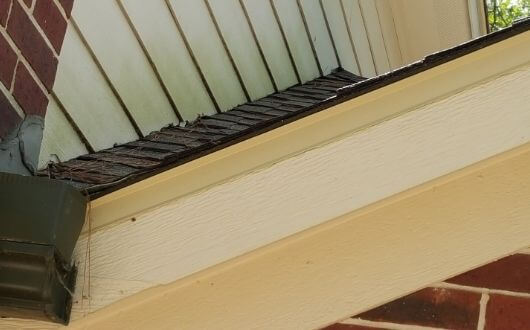
This is an excellent wood alternative that gets a lot of attention since it lasts longer and is more durable as compared to wood. This trim is manufactured from a mixture of Portland cement, cellulose fibers, silica, and sand.
To get a realistic-looking wood grain, the mixture is then poured into a mold. This trim can be found painted or primed to make the finish easier. Nevertheless, most fiber-cement trim products are quite expensive compared to their wooden counterparts, however, they do last a lot longer than other types of trim. See the James Hardie website for more details on exterior trim.
It is another solid wood alternative that has become popular among builders and homeowners in recent years. Engineered wood may come in different forms and is normally made of a blend of some resins, glue, and wood.
At times, it may come already painted or stained to make the installation process easier. Besides, it is less expensive as compared to solid wood. Nevertheless, nearly all engineered woods have the same problems with moisture.
The most common is that they tend to break down and swell up when exposed to high humidity. We don’t recommend using engineered wood trim on any part of your home.
It is among the oldest materials around. Redwood and Cedar are the most common woods used on trim as they can resist insect activity and moisture naturally. It makes them last longer as compared to other types of wood.
Since solid wood is becoming more scarce, the price has significantly risen. For this reason, builders have started using other less expensive alternatives. Unfortunately, other types of solid wood are less resistant to rot as compared to Redwood and Cedar, meaning they cannot last as long.
Before painting, both Redwood and Cedar require priming to avoid compromising the surface appearance resulting from a stain compromised surface finish and extractive bleeding. For this reason, solid wood may take a relatively long time to work with, resulting in higher material costs as well as labor costs.
Among the most common trim terms, you will hear getters, boxend, soffit, barge, rake, frieze, and fascia. However, if you are having a conversation with an expert in the exterior renovation, there are some other terms that you ought to be familiar with.
These terms include:
Knee braces or brackets were commonly used to hold up wide roof overhangs in historic homes. Knee braces were designed to be critical features of architecture and not just structural. In these modern times, the majority of knee braces are entirely for decorative purposes. Nevertheless, if applied in the right home, they add style.
Channels are specialized molding in which soffit and siding panels fit into. They enclose siding and soffit panel ends, thus preventing them from getting exposed to different elements. Besides, they prevent the siding pieces from popping free and support the hanging soffit’s weight.
The areas where soffits and sidings change directions are referred to as corners. The majority of corners are either outside or inside on your home’s vertical surface. However, they also appear in the horizontal spots where your gutter lines and walls meet the soffits.
Over the top of door trims and windows, drip caps are placed. They have a defined leading edge that minimizes the surface tension of water, thus making it drip off or break.
Flashing helps to control water from leaking into your home. Flashing is commonly used around skylights and chimneys or in roof shingles that surround any pipe jacks and vents. Flashing is also used in the edges that connect the siding to the roof like this picture down below:
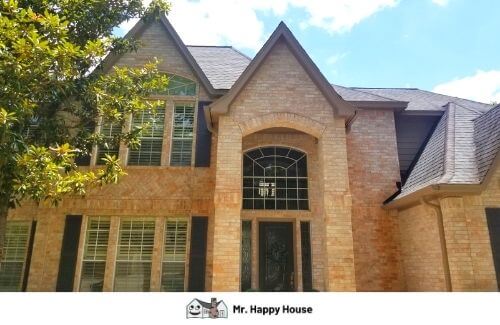
Now that you have gained a little bit more insight about what exterior trim is and the types of exterior trim out there, you are now more educated and can make the right decisions when it comes to repairing or adding any exterior features to your home such as the exterior trim, soffit, fascia, and siding.
Mr. Happy House is a highly rated siding company in the Houston area, and we specialize in siding repairs and exterior trim installation. If you’re in need of repairing your exterior trim, feel free to contact us today to learn more about how we can help you make your house happy!

Best GAF Certified Roofers in The Woodlands, TX – Quality Roof Replacement, Gutters & Siding
Best GAF Certified Roofers in The Woodlands, TX – Quality Roof Replacement, Gutters & Siding Best GAF Certified Roofers in The Woodlands, TX – Quality
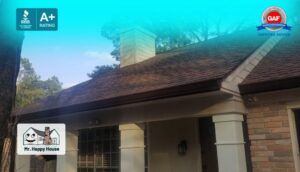
Are Gutters Part of the Roofing System?
Are Gutters Part of the Roofing System? Are Gutters Part of the Roofing System? When it comes to home maintenance, gutters often seem like a

Why James Hardie is The Best Option for Home Siding
Why James Hardie is The Best Option for Home Siding Why James Hardie is The Best Option for Home Siding James Hardie stands out whether
Our Services:












Schedule a Free Estimate Today!











